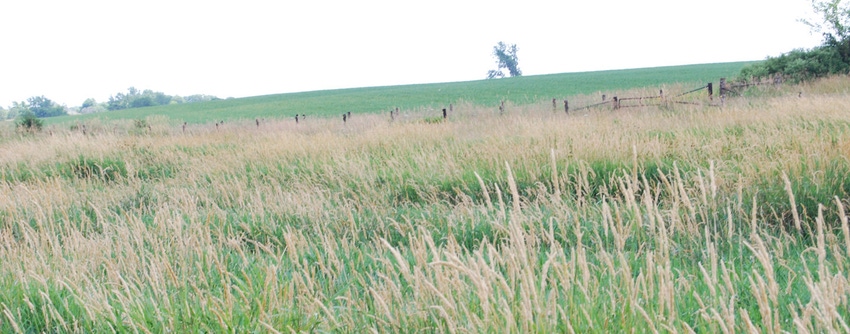July 22, 2016

In June, Russell Mauch — who is 6 foot, 3 inches tall — walked out into a field of Red River Valley corn that was nearly up to his waist. He raised his arms, spread them wide and shouted, “This was the middle of a wetland.”
But it’s not a wetland anymore.
Mauch, of Barney, N.D., moved the wetland. Or in Natural Resources Conservation Service terms, he “mitigated” it.
As a result, the spot where Mauch stood is now in the one of most productive cornfields on his farm.
Authorized in the 1985 Farm Bill, and used widely in many other Corn Belt states, wetland mitigation has been “moved to the front burner” in North Dakota, says Jennifer Heglund, an assistant state conservationist with the Natural Resources Conservation Service.
It’s a tool farmers can use to stay in compliance with wetland regulation, while they improve management on their farmland, she says.
In South Dakota, there have only been a handful of wetlands moved by farmers. At press time, groups were awaiting an announcement that a grant for wetland mitigation had been approved by USDA.
The wetland that Mauch moved was just outside of Wyndmere, N.D. It was small, only about a half an acre; and it was shallow, only about 6 to 12 inches deep.
“It was a small bowl, a depression,” Mauch explains.
NRCS had certified it as a wetland, protecting it from being drained or otherwise manipulated in accordance with USDA program eligibility requirements. Sometimes the wetland dried out enough so that it could be planted. But the $600 per acre Mauch spent on the seed, chemical and other inputs when growing corn was often wasted. The crop flooded out and nitrogen disappeared in the first heavy rain.
Mauch wanted to tile the field. However, NRCS’ technical criteria for his Wyndmere soils called for a 620-foot buffer around the wetland to protect its hydrology.
“There wasn’t an efficient way to tile the field given where the wetland was,” Mauch says.
So he asked NRCS if he could move it. The wetland qualified for mitigation.
“The best candidates are seasonal, isolated, degraded cropped wetlands that typically get driven over, tilled and sprayed each year,” Heglund says.
Mauch had to submit plans for replacing the wetland to NRCS and the agency’s staff had to verify that the new wetland was going to be the same size, would provide the same environmental and habitat value, and was going to be in the same watershed as the original.
Mauch moved the wetland to the opposite end of the quarter section. The landlord’s abandoned farmstead site was still there. The building and corrals had been removed, but the trees were still there and the land hadn’t been tilled. By moving thousands of yards of soil, Mauch turned a former sheep yard into a wetland. It is now filled with water and cattails, and is surrounded by grass and cottonwoods.
Moved 13 wetlands
Mauch has moved 13 wetlands covering 16 acres over the past seven years. He created most of the wetlands on land that had a creek running through it. The land had been farmed at one time and had been in the Conservation Reserve Program.
Mauch hired Houston Engineering, of Fargo, N.D., to design a series of wetlands next to the creek. Each wetland has to be separate from the others, and water can’t flow from one to another, Mauch notes. NRCS approved the design, and Mauch moved the dirt to create the wetlands himself. He has a backhoe, scraper and other earth-moving equipment. NRCS approved the final construction.
“It’s not cheap to build wetlands,” Mauch says. He spent a lot time overseeing the projects, invested $12,000 for the engineering plans and has kept on a hired man each summer for the last several years to dig the wetlands.
Mitigation value
Mitigation has been worthwhile, Mauch says. After moving wetlands, he has been able to finish tiling all of his farmland, which has greatly stabilized yields and promises to increase yields by draining away excess water. He has put wetlands that he wasn’t able to mitigate into the Farmable Wetland Reserve Program, a CRP-like program. He has to control the weeds on the land, and can’t hay or graze it. The annual payment is similar to the cash rent in the area.
Creating and preserving wetlands has increased habitat for wildlife, Mauch says.
“I see a lot of deer, pheasants and ducks out here,” he says.
Mauch doesn’t hunt in the fall. He�’s too busy with corn and sugarbeet harvest. But others enjoy it.
“I don’t post any of the wetlands. They are open to everyone,” he says.
After years of disagreeing with NRCS about wetland issues and lobbying Congress to change wetland rules, Mauch — former president of the American Sugarbeet Growers Association — is happy to have a workable solution.
“Being able to mitigate wetlands and enroll wetlands in a conservation program has been a win-win-win,” he says, “It’s a win for me, a win for hunters, and a win for USDA.”
Learn more
To learn more about wetland mitigation, contact your local NRCS office. Also, check out its Wetland Mitigation Fact Sheet.
You May Also Like




